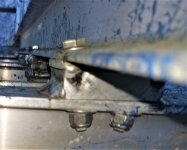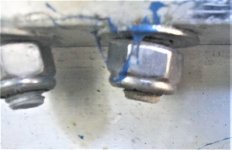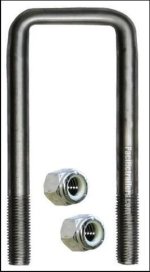-
If you log in, the ads disappear in the forum and gallery. If you need help logging in or getting registered, send request to: webmaster@southernairboat.com
You are using an out of date browser. It may not display this or other websites correctly.
You should upgrade or use an alternative browser.
You should upgrade or use an alternative browser.
Maintaining Bolt Torque
- Thread starter Old Yeller
- Start date
SWAMPHUNTER45
Well-known member
It looks as if your already running a poly nut on there. Were the poly nuts new or did they already have use on them?
I find after use they won’t hold as well FYI.
Tricks we have used on difficult applications have been to use a commercial thread lock like LocTite. The Red #271 is a permanent thread lock compound. If it is the nut coming loose and not bolt stretch, the #271 product will stop it.
Another less intrusive trick is to put a smear of High Quality RTV sealer such as Permatex high heat on one side of the threads and tighten it down then allow 24 hours to cure. Make sure the bolt and nut are clean and dry. The objective is for the sealer to bond and created a filler in the threads and barrier to backing off. Put a little up under the nut after tightening also. Just a pea size amount and wipe the bolt and nut base.
I suspect part of the issue is that the nuts can’t torque flat as they are drilled in at an angle so any flex is working to mechanically loosen the nut. It they were flat the added surface tensions would hold better.
I find after use they won’t hold as well FYI.
Tricks we have used on difficult applications have been to use a commercial thread lock like LocTite. The Red #271 is a permanent thread lock compound. If it is the nut coming loose and not bolt stretch, the #271 product will stop it.
Another less intrusive trick is to put a smear of High Quality RTV sealer such as Permatex high heat on one side of the threads and tighten it down then allow 24 hours to cure. Make sure the bolt and nut are clean and dry. The objective is for the sealer to bond and created a filler in the threads and barrier to backing off. Put a little up under the nut after tightening also. Just a pea size amount and wipe the bolt and nut base.
I suspect part of the issue is that the nuts can’t torque flat as they are drilled in at an angle so any flex is working to mechanically loosen the nut. It they were flat the added surface tensions would hold better.
Old Yeller
Well-known member
Thank You!
Anyone else have this "S" Section Rib bolt up issue?
Anyone else have this "S" Section Rib bolt up issue?
Slidin Gator
Well-known member
You need beveled I-beam washers to level out under the nut. Normally you drill the hole straight and put them under the I-beam flange, but they should work under the nut for the angle the holes are drilled at.

McMaster has them in SST and Aluminum.
https://www.mcmaster.com/wedge-washers/

McMaster has them in SST and Aluminum.
https://www.mcmaster.com/wedge-washers/
Old Yeller
Well-known member
That should do the trick! THANK YOU!
Slidin Gator
Well-known member
Your welcome Yeller. Not that it matters to you much more much but here's the skinny in case it helps someone select metal for a build.
You didn't get many responses because most boats are built with beams and channels made to "Aluminum Association" standards, which have constant thickness flanges, easy to bolt to. Your beams are "American Standard" which match steel shapes with tapered flanges. The tapered flange is the most structurally efficient, using the least amount of metal for a given strength, they have their place and they are saving you a few pounds. But as you show, the taper creates other issues. Your about to add back the weight savings in washers. :banghead:
You didn't get many responses because most boats are built with beams and channels made to "Aluminum Association" standards, which have constant thickness flanges, easy to bolt to. Your beams are "American Standard" which match steel shapes with tapered flanges. The tapered flange is the most structurally efficient, using the least amount of metal for a given strength, they have their place and they are saving you a few pounds. But as you show, the taper creates other issues. Your about to add back the weight savings in washers. :banghead:
Old Yeller
Well-known member
I appreciate the help GREATLY! I'll call McMaster Monday and see if they can get me 110 5/16" in 316SS. I doubt CG will let me get away with 18-8 or an unk ali spec. Thank You Again!
Old Yeller
Well-known member
Old Yeller
Well-known member
Anyone else with this issue on an inspected airboat that found a 176.700 approved solution?
Slidin Gator
Well-known member
Given the issues you have shown, I'd start looking for a 176.700 approved aluminum welder to eliminate this particular issue for you so you can get back to making money with this boat.
SWAMPHUNTER45
Well-known member
X2 what SG said
Gator why would they build the boat that way ? Does that design of beam offer enhanced strength if so it would make a layman go WTF how are you supposed to marry the beams and maintain the structural integrity.
WHY?
Gator why would they build the boat that way ? Does that design of beam offer enhanced strength if so it would make a layman go WTF how are you supposed to marry the beams and maintain the structural integrity.
WHY?
Slidin Gator
Well-known member
Slidin Gator said:Your welcome Yeller. Not that it matters to you much more much but here's the skinny in case it helps someone select metal for a build.
You didn't get many responses because most boats are built with beams and channels made to "Aluminum Association" standards, which have constant thickness flanges, easy to bolt to. Your beams are "American Standard" which match steel shapes with tapered flanges. The tapered flange is the most structurally efficient, using the least amount of metal for a given strength, they have their place and they are saving you a few pounds. But as you show, the taper creates other issues. Your about to add back the weight savings in washers. :banghead:
Swamp,
If the holes were drilled straight, the I beam washers would be are the correct angle, just rotated 90 degrees from each other. But the off angle drill results in a different compound angle so these particular washers won't work. They could be modified at a machine shop to match the angle(s) needed, but it looks like a hair pulling jigsaw puzzle. That said, American Standard beams are normally used in welded metal work. Aluminum Association beams should have been used originally in this application.
If you bought the boat for a inspected purpose and it doesn't pass inspection, why not take it back to manufacture and let them spend the $176? The other side is how long will it take to make the $176.00 , and what would it cost you for manufacture to do the mods. $176.00 doesn't seem like that much money to me. Bet you have more then that in safety equipment.
kwanjangnihm
Moderator
Gary I am pretty sure he is referring to 46 CFR 176.700 - Permission for repairs and alterations. (code of federal regulations)
Old Yeller
Well-known member
Thanks for clarifying 46CFR176.700 kwanjangnihm
Slidin Gator & SWAMPHUNTER45: You are both spot on. We did get a previous approval on a different hull with a combination wedge washer/red locktite on jack blocks as shown. The wedges were machined from the I beam spec, properly drilled with a shouldered 5/16” in 316SS.
I’ll mention welding and bolting up with new clips to USCG and test the water… afraid we’d be chasing cracks, we’re dealing with 5 ribs each attached to 11 stringers.

Gary S I have to submit a request for repairs and alterations to the USCG-OCMI (Officer in Charge of Marine Inspection) detailing the modifications. Inspected are built to USCG Approved Plans and we are held to them. Also, the 176.700 may not be a permanent solution, I have seen USCG overrule a mod years later and have it returned to the original approved plan. My first request to ”accept as is with the 5/16” x (?) bolts and jack blocks” has been working it’s way up Chain of Command for more than six weeks now, I’m no longer hopeful it will be approved. My hope is to get ideas and submit another request that avoids the OCMI ordering the infamous “crop & renew” (a/k/a cut it all out and start over) directive.
Slidin Gator & SWAMPHUNTER45: You are both spot on. We did get a previous approval on a different hull with a combination wedge washer/red locktite on jack blocks as shown. The wedges were machined from the I beam spec, properly drilled with a shouldered 5/16” in 316SS.
I’ll mention welding and bolting up with new clips to USCG and test the water… afraid we’d be chasing cracks, we’re dealing with 5 ribs each attached to 11 stringers.

Gary S I have to submit a request for repairs and alterations to the USCG-OCMI (Officer in Charge of Marine Inspection) detailing the modifications. Inspected are built to USCG Approved Plans and we are held to them. Also, the 176.700 may not be a permanent solution, I have seen USCG overrule a mod years later and have it returned to the original approved plan. My first request to ”accept as is with the 5/16” x (?) bolts and jack blocks” has been working it’s way up Chain of Command for more than six weeks now, I’m no longer hopeful it will be approved. My hope is to get ideas and submit another request that avoids the OCMI ordering the infamous “crop & renew” (a/k/a cut it all out and start over) directive.
Attachments
Old Yeller
Well-known member
Slidin Gator
Well-known member
Old Yeller said:Is there any potential for approval of a U Bolt fix?
... if we replace the 30 T Bar "clips" on the odd stringers with longer ones that weren't tapered.
SS Sq U Bolt.JPG
Leave Existing Crossmembers as attached with jack blocks and 5-16 DSC05863 (2).JPG
Yeller,
From my perspective, that solution has legs. If the U bolt runs over the tapered beam but the holes are straight and the clips are flat (Aluminum Association Shape) so the nuts and washers sit flat, I would sign it off if I could. You have eliminated a lot of failure points with this solution. I view it as superior to the original even with everything jam up.
Old Yeller
Well-known member
A very interesting conversation with the MI last week regarding the “fix”.
Will it cause an immanent or catastrophic failure? -NO; Will it fail? -Yes; What will cause the failure? -Fretting from SS bolt threads along the surface grip area; When will the failure occur? -Unknown; What will the extent of the failure be? -Elongation of the bolt holes, most likely along the longitudinal stiffeners and clips where the washers are on edge.
… continue to patiently wait for authorization
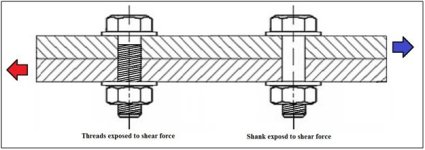
The use of full thread SS bolts in this application creates fretting, those used in shear appear much faster. Those of you using full thread SS bolts, whether aluminum or plastic construction, should consider pulling them out and inspecting for elongation, and replace with a shouldered bolt, rather than repeated attempts to keep them tight.
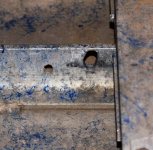
Will it cause an immanent or catastrophic failure? -NO; Will it fail? -Yes; What will cause the failure? -Fretting from SS bolt threads along the surface grip area; When will the failure occur? -Unknown; What will the extent of the failure be? -Elongation of the bolt holes, most likely along the longitudinal stiffeners and clips where the washers are on edge.
… continue to patiently wait for authorization

The use of full thread SS bolts in this application creates fretting, those used in shear appear much faster. Those of you using full thread SS bolts, whether aluminum or plastic construction, should consider pulling them out and inspecting for elongation, and replace with a shouldered bolt, rather than repeated attempts to keep them tight.

SWAMPHUNTER45
Well-known member
Good info for sure!







